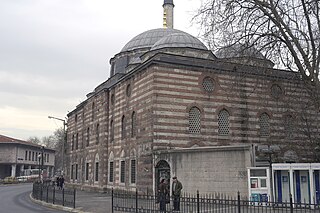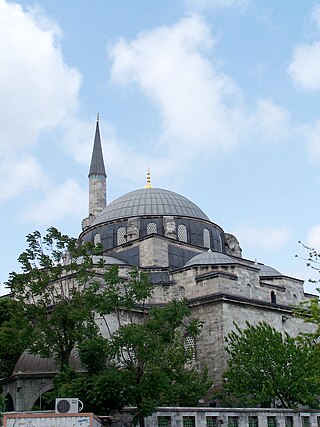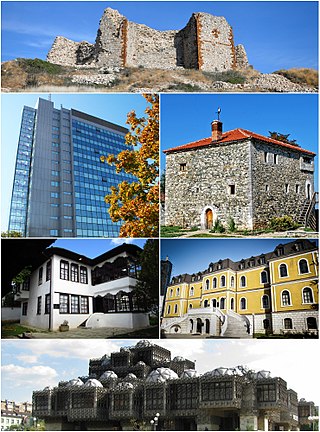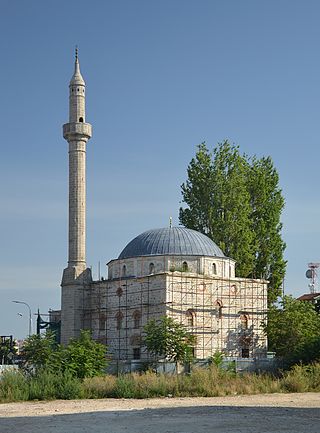Mehmet Yasar | |
|---|---|
 Jashar Pasha Mosque | |
| Mayor of Skopje | |
| In office 1842–1842 | |
Jashar Mehmet Pasha was a citizen of Pristina and also the mayor of Skopje in 1842. [1]
He built the Jashar Pasha Mosque in 1834. [2]
Mehmet Yasar | |
|---|---|
 Jashar Pasha Mosque | |
| Mayor of Skopje | |
| In office 1842–1842 | |
Jashar Mehmet Pasha was a citizen of Pristina and also the mayor of Skopje in 1842. [1]
He built the Jashar Pasha Mosque in 1834. [2]

Ahmed I was Sultan of the Ottoman Empire from 1603 until his death in 1617. Ahmed's reign is noteworthy for marking the first breach in the Ottoman tradition of royal fratricide; henceforth Ottoman rulers would no longer systematically execute their brothers upon accession to the throne. He is also well known for his construction of the Blue Mosque, one of the most famous mosques in Turkey.
Abdullah Gërguri (1931–1994) was a Kosovo Albanian artist in restoration and conservation of the icons and frescoes.

Pristina is the capital and largest city of Kosovo. The city's municipal boundaries in Pristina District form the largest urban center in Kosovo. After Tirana, Pristina has the second largest population of ethnic Albanians and speakers of the Albanian language.

The Sinan Pasha Mosque is an Ottoman mosque located in a densely populated district of Beşiktaş, in Istanbul, Turkey. It was built by the Ottoman architect Mimar Sinan for the admiral Sinan Pasha. The türbe (tomb) of Barbaros Hayrettin Pasha is located just across the street.

The Gazi Atik Ali Pasha Mosque is a 15th-century Ottoman mosque located in the Çemberlitaş neighbourhood of the Fatih district in Istanbul, Turkey. Its construction was started under the orders of the future Grand Vizier Hadım Atik Ali Pasha in 1496 and was completed in 1497, during the reign of Sultan Bayezid II. The mosque is located near the entrance to the Kapalıçarşı, the Column of Constantine, and the historical Nuruosmaniye Mosque.
Mesih Mehmed Pasha Mosque is a 16th-century Ottoman mosque in the Fatih district of Istanbul. It was commissioned by one of Murad III's grand viziers, Mesih Mehmed Pasha, and designed by the imperial architect Mimar Sinan. The mosque was completed in 1585–86.

Kosovo is situated in south-eastern Europe. With its central position in the Balkans, it serves as a link in the connection between central and south Europe, the Adriatic Sea, and Black Sea. Tourism in Kosovo is characterized by archaeological heritage from Illyrian, Dardanian, Roman, Byzantine, Serbian and Ottoman times, traditional Albanian and Serbian cuisine, architecture, religious heritage, traditions, and natural landscapes.

The Piyale Pasha Mosque, also known as the Tersane Mosque, is a 16th-century Ottoman mosque located in the Kasımpaşa neighborhood of the Beyoğlu district in Istanbul, Turkey.

Kosovo does not have an official religion. Like the rest of the country, the majority of Pristina's population consider themselves to be Muslim. However, religious practices may tend to be liberal. Many do fast for Ramadan and praying is widely practiced.

Historical monuments in Pristina are made up of 21 monuments out of a total of 426 protected monuments all over Kosovo. A large number of these monuments date back to the Byzantine and Ottoman periods. Since 1945, the Yugoslav authorities followed the idea of constructing a modern Pristina by relying in the urban development motto “destroy the old, build the new” and this resulted with major changes in the structure of the buildings, their function and their surrounding environment. However, numerous types of monuments have been preserved, including four mosques, a restored orthodox church, an Ottoman bath, a public fountain, a clock tower, several traditional houses as well as European-influenced architecture buildings such as the Museum of Kosovo. These symbolize the historical and cultural character of Pristina as it was developed throughout centuries in the spirit of conquering empires.

Tourism in Pristina attracted 36,186 foreign visitors in 2012, which represents 74.2% of all visitors that visited Kosovo during that year. Foreign visitors mostly come from countries like Albania, Turkey, Germany, United States, Slovenia and North Macedonia, but also from other countries. Some of the most visited places in Pristina are Batlava Lake and Gadime Marble Cave, which are also among the most visited places in Kosovo.

The architecture of Kosovo dates back to the Neolithic period and includes the Copper, Bronze and Iron Ages, Antiquity and the Medieval period. It has been influenced by the presence of different civilizations and religions as evidenced by the structures which have survived to this day. Local builders have combined building techniques of conquering empires with the materials at hand and the existing conditions to develop their own varieties of dwellings.

The Imperial Mosque also known as King's Mosque is an Ottoman mosque located in Pristina, Kosovo. It was built in 1461 by Sultan Mehmed II.

The Jashar Pasha Mosque is a Mosque in Prishtina, Kosovo. It was named after Mehmet Yasar.

The Sokollu Mehmed Pasha Mosque is a 16th-century Ottoman mosque located in Istanbul, Turkey.

Gruemiri is a small historical Albanian tribe (fis) in the former municipality of Gruemirë in the region of Malësia.
Jashar Salihu was a Kosovo Albanian general, diplomat and activist who fought for the Kosovo Liberation Army (KLA) during the Kosovo War. He was known for his political efforts and advocacy for the independence of Kosovo, his diplomatic role with the People's Movement of Kosovo (LPK) and also for his work as chairman of the Homeland Calls fund for the KLA.

The Çarshi Mosque, also known as the Bazaar Mosque and the Taş Mosque, is the oldest building in Pristina and it marks the beginning of the old town. The foundation of this mosque was laid out in 1389 during the rule of the Ottoman Sultan Bayezid I and its construction was continued during the reign of Sultan Murad II in the 15th century. The Çarshi Mosque was built to celebrate the Ottoman victory of 1389 in the Battle of Kosovo. Over the years, the mosque has undergone through several restorations. However, its stone-topped minaret has survived for over six centuries.

The Clock Tower was built in the 19th century by Jashar Pasha, after whom the Mosque is named not far from the Clock Tower. It served as a means of informing the town during the Ottoman Empire rule, in order to let people know when to pray as well as the traders closing their shops. The 26-meter high hexagonal clock tower was made of sandstone and bricks. The original tower was burned in fire and its bricks were used for reconstruction. The authentic bell was brought from Moldavia and has an inscription mentioning this fact. However, the circumstances of how the bell was brought to Pristina are not clearly known; its theft in 2001 is even more unclear. The same year, French KFOR troops assisted in installing a new clock by changing the old clock mechanism with an electric one.